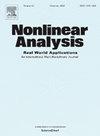Analysis of a mathematical model for low-grade gliomas under chemotherapy as a dynamical system
IF 1.8
3区 数学
Q1 MATHEMATICS, APPLIED
引用次数: 0
Abstract
We analyze dynamical system properties of a 3-compartment mathematical model for the cell-cycle under chemotherapy with a phase non-specific drug. It is assumed that the drug damages both proliferating and quiescent cells, but possibly at different rates. While damage to proliferating cells is lethal, damaged quiescent cells may be repaired and can reenter the cell cycle. We prove that there exists a unique dosage (depending only on the parameters of the dynamics of the system) such that the tumor can be eradicated for as all trajectories converge to the tumor-free equilibrium point (global stability). For lower doses, , however, there exists a locally asymptotically stable equilibrium point with positive values and such doses are not sufficient to eradicate the tumor. Mathematically, for , the positive and tumor-free equilibrium points are equal and a transcritical or exchange of stability bifurcation occurs. Our theoretical analysis is independent of specific values of the parameters. For the numerical illustration of the results we use clinically validated parameter values for low-grade glioma from Ribba et al., (2012).
化疗下低级别胶质瘤的动态系统数学模型分析
我们分析了一个3室数学模型的动力系统特性,在化疗与阶段非特异性药物。据推测,该药对增殖细胞和静止细胞都有损害,但损害程度可能不同。虽然对增殖细胞的损伤是致命的,但受损的静止细胞可能被修复并可以重新进入细胞周期。我们证明了存在一个唯一的剂量(仅取决于系统动力学参数),使得当所有轨迹收敛于无肿瘤平衡点(全局稳定)时,肿瘤可以被根除。对于较低的剂量,0≤u< n,存在一个局部渐近稳定的平衡点,且该平衡点为正值,此剂量不足以根除肿瘤。在数学上,对于u= n,正平衡点和无平衡点相等,发生跨临界或交换稳定性分岔。我们的理论分析与具体的参数值无关。为了对结果进行数值说明,我们使用了Ribba等人(2012)对低级别胶质瘤的临床验证参数值。
本文章由计算机程序翻译,如有差异,请以英文原文为准。
求助全文
约1分钟内获得全文
求助全文
来源期刊
CiteScore
3.80
自引率
5.00%
发文量
176
审稿时长
59 days
期刊介绍:
Nonlinear Analysis: Real World Applications welcomes all research articles of the highest quality with special emphasis on applying techniques of nonlinear analysis to model and to treat nonlinear phenomena with which nature confronts us. Coverage of applications includes any branch of science and technology such as solid and fluid mechanics, material science, mathematical biology and chemistry, control theory, and inverse problems.
The aim of Nonlinear Analysis: Real World Applications is to publish articles which are predominantly devoted to employing methods and techniques from analysis, including partial differential equations, functional analysis, dynamical systems and evolution equations, calculus of variations, and bifurcations theory.

 求助内容:
求助内容: 应助结果提醒方式:
应助结果提醒方式:


